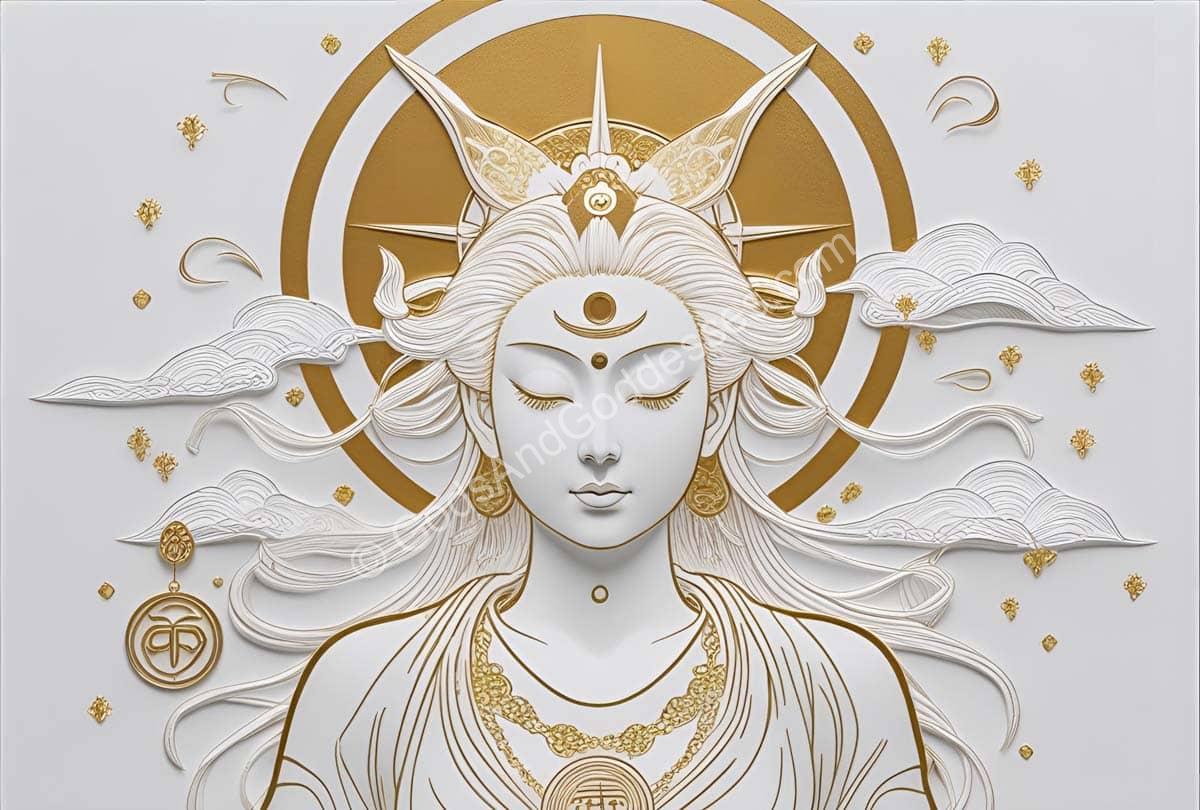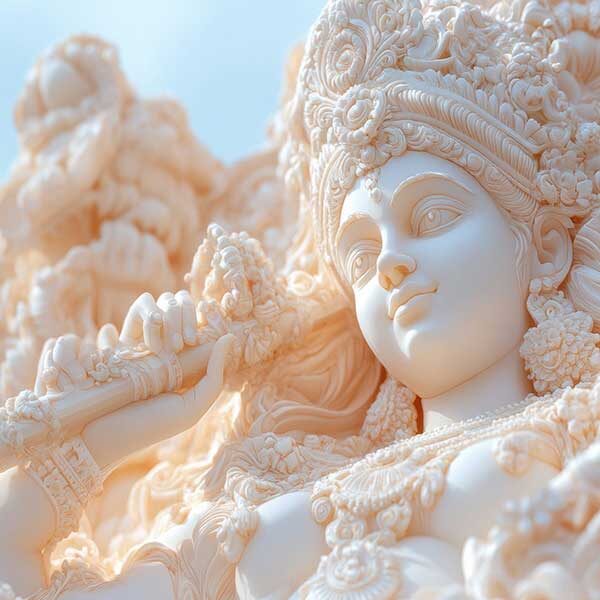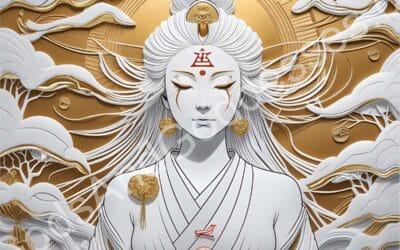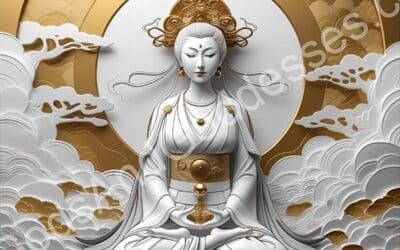Introduction: Why Amaterasu Matters
Among the most revered and radiant deities in Japanese mythology is Amaterasu-ōmikami, the Shining Goddess of the Sun. As the celestial ancestor of Japan’s imperial family and ruler of the heavens, Amaterasu embodies light, order, and the life-giving power of the sun itself. Her presence ensures the turning of the seasons, the flourishing of rice fields, and the spiritual clarity of the nation.
Yet her story is not without shadows—moments of retreat, grief, and cosmic imbalance. When she hid herself in a cave, darkness fell over the world, and only divine ingenuity could lure her back into the light. Through this myth, Amaterasu becomes more than a solar goddess—she is the very rhythm of loss and return, absence and illumination.
At GodsAndGoddesses.com, we explore gods and goddesses, including Japanese Goddesses, Goddess Types, and Goddess Symbols to reveal how figures like Amaterasu guide the sacred dance between darkness and light.
“When Amaterasu withdrew, the world fell into shadow. When she returned, life resumed its radiant course.”
See also: Mythology.
Key Takeaways About Amaterasu
-
Amaterasu is the Japanese sun goddess and a central Shinto deity.
-
She governs light, truth, fertility, and the spiritual harmony of the world.
-
Her temporary withdrawal into a cave caused darkness and disorder in heaven and earth.
-
She was lured back through ritual, joy, and the mirror—a key Shinto symbol.
-
Amaterasu is revered as the divine ancestor of Japan’s emperors and honored in shrines across the country, most notably at Ise Grand Shrine.
Who Is Amaterasu?
Amaterasu’s name means “Shining in Heaven.” She is the daughter of Izanagi, who birthed her after his purification ritual, following his descent into the underworld. As the goddess of the sun, she is among the most important kami in Shinto.
She governs:
-
The Sun and Light – Bringing warmth and order to the world.
-
Sovereignty – Ancestor of Japan’s emperors, legitimizing their divine rule.
-
Purity and Renewal – Symbolized in rituals of cleansing and reflection.
Her dwelling is said to be the high celestial plain, Takamagahara, from which she oversees the world.
Myths of Amaterasu
The Cave of Darkness (Ama-no-Iwato)
Amaterasu’s most famous myth tells of her retreat into a cave after her stormy brother Susanoo desecrated her sacred space. Enraged, she withdrew, plunging the world into darkness.
The other kami lured her out by staging a joyous dance led by Ame-no-Uzume, who exposed herself and caused great laughter. Curious, Amaterasu peeked out, and a sacred mirror reflected her brilliance back to her. Enticed, she emerged, restoring light to the world.
This myth symbolizes:
-
The renewal of light after darkness.
-
The power of ritual, joy, and reflection.
-
The need for balance between chaos (Susanoo) and order (Amaterasu).
The Imperial Line
Amaterasu gave her grandson Ninigi-no-Mikoto the Three Sacred Treasures of Japan:
-
Mirror – Truth and purity.
-
Jewel (Magatama) – Benevolence and connection.
-
Sword (Kusanagi) – Courage and strength.
These regalia became the symbols of Japan’s imperial family, establishing their divine ancestry.
Domains and Powers of Amaterasu
-
Solar Power – Source of life, warmth, and growth.
-
Order and Authority – Embodying harmony, justice, and rulership.
-
Purity and Reflection – Through mirrors and rituals of cleansing.
-
Renewal and Cycles – Representing the rising sun and eternal return of light.
See also: Goddess Types.
Symbols of Amaterasu
-
The Mirror (Yata no Kagami) – A sacred object, symbolizing truth and reflection.
-
Sun Disc – A glowing circle of radiance, often linked to Japan’s flag.
-
Imperial Regalia – Mirror, jewel, and sword, tying her to Japan’s emperors.
-
Light and Radiance – Her essence itself, shining as the sun.
See more: Goddess Symbols.
Worship and Rituals
Amaterasu remains one of the most actively worshiped deities in Japan.
-
Ise Grand Shrine (Ise Jingū) – Her most sacred shrine, rebuilt every 20 years in ritual renewal.
-
Daily Rituals – Shinto priests offer prayers and offerings of food and light.
-
Festivals – Celebrations of renewal, harvest, and light honor her throughout Japan.
See also: Goddess Worship and Rituals.
Archetypes of Amaterasu
Amaterasu embodies:
-
The Sovereign Queen – Authority and legitimacy of rulers.
-
The Light Bringer – Illumination, truth, and renewal.
-
The Hidden One – Retreating in the cave, symbolizing shadow and return.
Her myths place her alongside global archetypes of solar deities, but her uniquely feminine and maternal qualities set her apart.
Amaterasu in Modern Culture
-
National Symbol – The Japanese flag (hinomaru) reflects her rising sun.
-
Ritual and State – The emperor’s legitimacy still traces back to her lineage.
-
Media and Literature – Amaterasu appears in anime, manga, and fantasy, often as a radiant solar figure.
-
Global Mythology – Seen as one of the most prominent female solar deities worldwide.
External reference: Britannica – Amaterasu.
FAQs About Amaterasu
What is Amaterasu the goddess of?
The sun, light, and order.
Where is Amaterasu worshiped?
Primarily at the Ise Grand Shrine, one of Japan’s holiest sites.
Why did Amaterasu hide in a cave?
To escape Susanoo’s destruction, symbolizing withdrawal and renewal.
What are her symbols?
The mirror, sun disc, and imperial regalia.
Conclusion
Amaterasu is the radiant heart of Japanese mythology: a goddess of the sun, of sovereignty, and of renewal. Her myths illuminate the balance between chaos and order, darkness and light, mortality and divinity.
To honor Amaterasu is to honor the rising sun itself—the eternal promise of renewal and the brilliance that sustains life.
Explore further with:
“Amaterasu shines not only in the heavens, but in every sunrise that begins the world anew.”
- Odin God Story - August 24, 2025
- The Story of Ra: Egyptian Sun God and Creator - August 24, 2025
- Kraken: Mythological Sea Monster of the Deep - August 24, 2025




